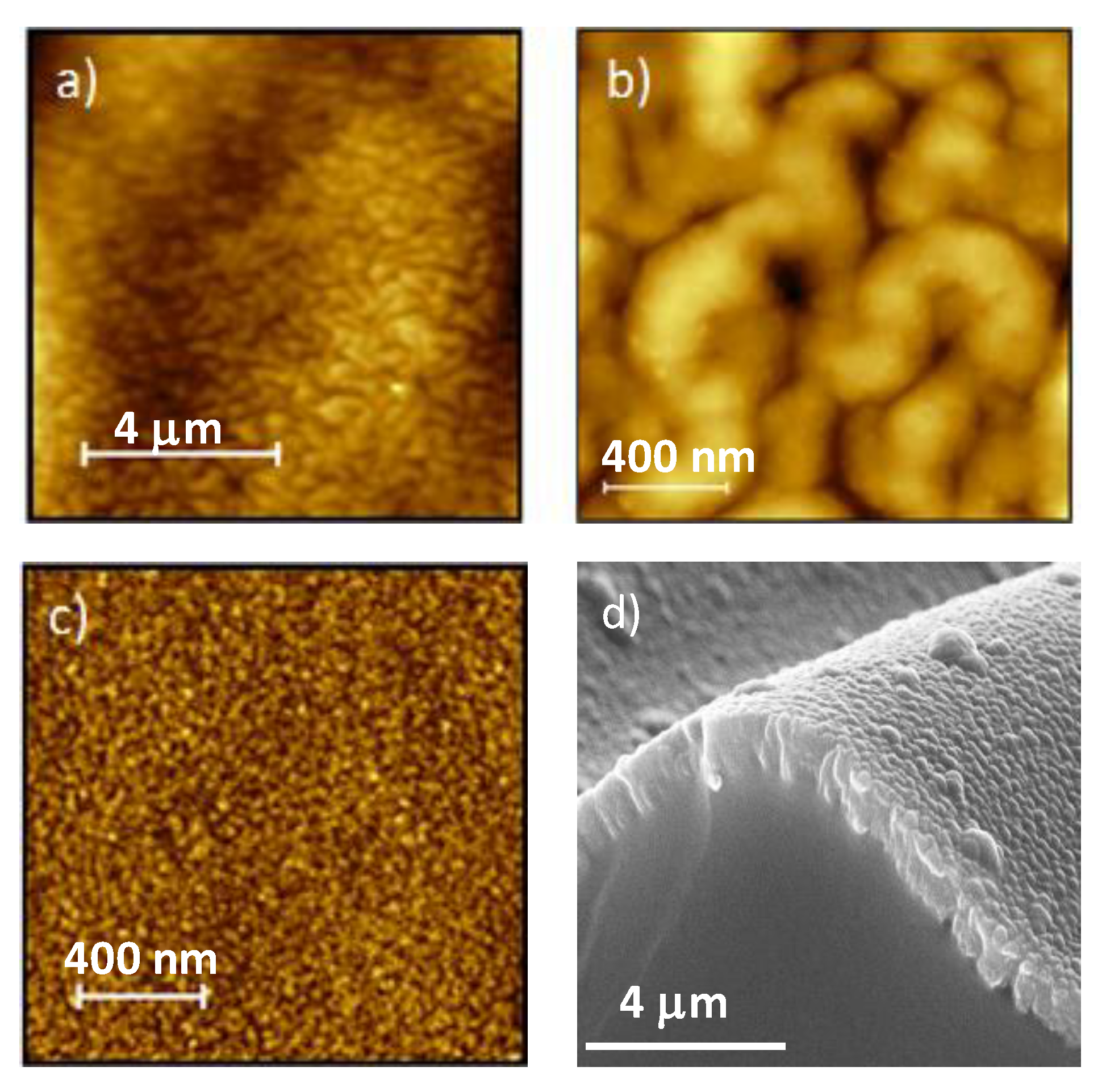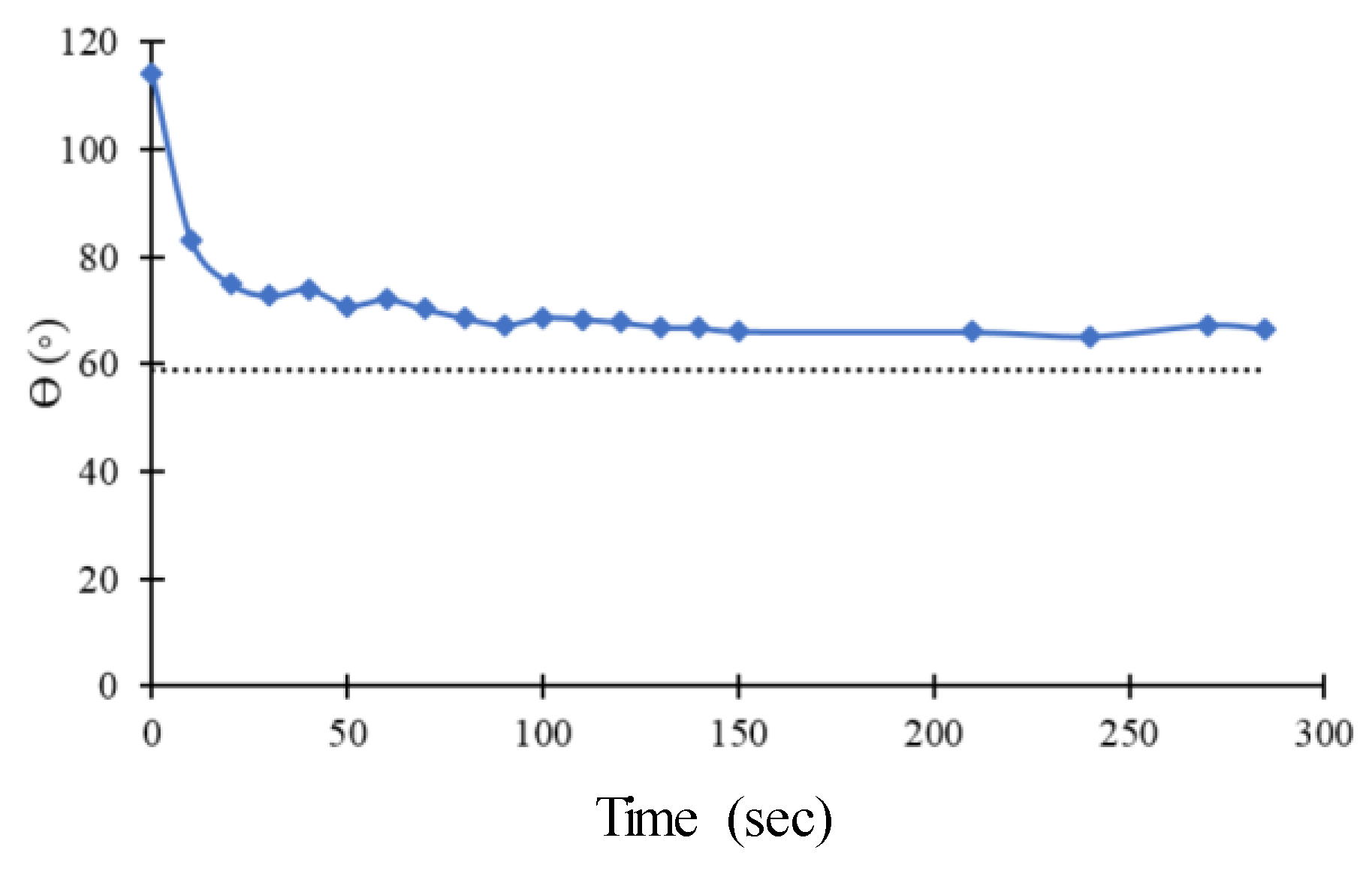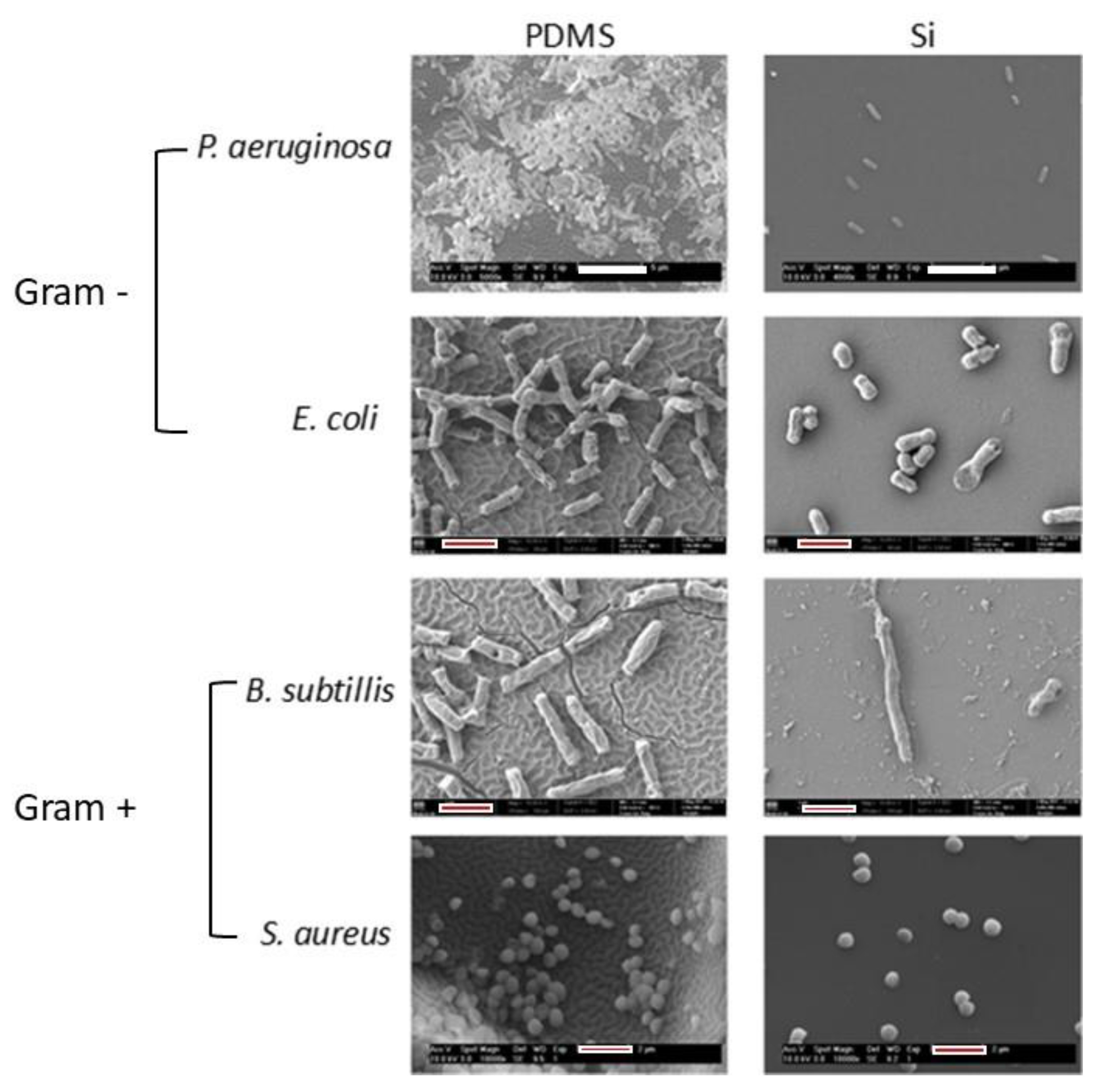Influence of Extracellular Mimicked Hierarchical Nano-Micro-Topography on the Bacteria/Abiotic Interface
Abstract
:1. Introduction
2. Experimental Section
2.1. Surface Modification
2.2. Surface Topography and Morphology
2.3. Structural Characterization
2.4. Chemical Analysis
2.5. Wettability and Surface Charge
2.6. Mechanical Properties
2.7. Microbial in Vitro Tests
3. Results and Discussion
3.1. Preliminary Study
3.2. Surface Characterization
3.3. Microbial in Vitro Tests
4. Conclusions
Author Contributions
Funding
Acknowledgments
Conflicts of Interest
References
- Christo, S.N.; Bachhuka, A.; Diener, K.R.; Mierczinska, A.; Hayball, J.D.; Vasilev, K. The role of surface nanotopography and chemistry on primary neutrophil and macrophage cellular responses. Adv. Healthc. Mater. 2016, 5, 956–965. [Google Scholar] [CrossRef] [PubMed]
- Li, M.; Joung, D.; Hughes, B.; Waldman, S.D.; Kozinski, J.A.; Hwang, D.K. Wrinkling non-spherical particles and its application in cell attachment promotion. Sci. Rep. 2016, 6, 30463. [Google Scholar] [CrossRef] [Green Version]
- Wang, Y.L.; Deng, J.J.; Fan, R.R.; Tong, A.P.; Zhang, X.N.; Zhou, L.X.; Zheng, Y.; Xua, J.G.; Guo, G. Novel nanoscale topography on poly(propylene carbonate)/poly(ε-caprolactone) electrospun nanofibers modifies osteogenic capacity of ADCs. RSC Adv. 2015, 5, 82834–82844. [Google Scholar] [CrossRef]
- Zou, F.; Zhou, H.; Jeong, D.Y.; Kwon, J.; Eom, S.U.; Park, T.J.; Hong, S.W.; Lee, J. Wrinkled surface-mediated antibacterial activity of graphene oxide nanosheets. ACS Appl. Mater. Interfaces 2017, 9, 1343–1351. [Google Scholar] [CrossRef]
- Alves, N.M.; Pashkuleva, I.; Reis, R.L.; Mano, J.F. Controlling cell behavior through the design of polymer surfaces. Small 2010, 6, 2208–2220. [Google Scholar] [CrossRef] [PubMed] [Green Version]
- Piedade, A.P.; Gil, M.H.; Cavaco, M.C.; Andrade, M.E. Behaviour of catalase immobilised on poly(acrylonitrile)-g.co-hydroxyethyl methacrylate when used in a continuous system. Polym. Int. 1995, 38, 269–275. [Google Scholar] [CrossRef]
- DaSilva, M.A.; Gil, M.H.; Piedade, A.P.; Redinha, J.S.; Brett, A.M.O.; Costa, J.M.C. Immobilization of catalase on membranes of poly(ethylene)-g.co-acrylic acid and poly(tetrafluoroethylene)-g.co-acrylic acid and their application in hydrogen peroxidase electrochemical sensors. J. Polym. Sci. A 1991, 29, 269–274. [Google Scholar] [CrossRef]
- Brett, A.M.C.F.O.; Gil, M.H.; Piedade, A.P. An electrochemical bienzyme membrane sensor for free cholesterol. Bioelectrochem. Bioenerg. 1992, 28, 105–115. [Google Scholar] [CrossRef]
- Rodríguez-Hernández, J. Wrinkled interfaces: Taking advantage of surface instabilities to pattern polymer surfaces. Prog. Polym. Sci. 2015, 42, 1–176. [Google Scholar] [CrossRef]
- Zhou, Q.; Kühn, P.T.; Huisman, T.; Nieboer, E.; van Zwol, C.; Kooten, T.G.; van Rijn, P. Directional nanotopographic gradients: A high-throughput screening platform for cell contact guidance. Sci. Rep. 2015, 5, 16240. [Google Scholar] [CrossRef] [Green Version]
- Cheng, Y.; Feng, G.; Moraru, C.I. Micro- and nanotopography sensitive bacterial attachment mechanisms: A review. Front. Microbiol. 2019, 10, 191. [Google Scholar] [CrossRef] [PubMed] [Green Version]
- Erramilli, S.; Genzer, J. Influence of surface topography attributes on settlement and adhesion of natural and synthetic species. Soft Matter 2019, 15, 4045–4067. [Google Scholar] [CrossRef] [PubMed]
- Rigo, S.; Cai, C.; Gunkel-Grabole, G.; Maurizi, L.; Zhang, X.; Xu, J.; Palivan, C.G. Nanoscience-based strategies to engineer antimicrobial surfaces. Adv. Sci. 2018, 5, 1700892. [Google Scholar] [CrossRef] [PubMed]
- Li, B.; Cao, Y.P.; Feng, X.Q.; Gao, H. Mechanics of morphological instabilities and surface wrinkling in soft materials: A review. Soft Matter 2012, 8, 5728. [Google Scholar] [CrossRef]
- Adam, A.; Paulkowski, D.; Mayer, B. Friction and deformation behavior of elastomers. Mater. Sci. Appl. 2019, 10, 527–542. [Google Scholar] [CrossRef] [Green Version]
- Piedade, A.P.; Nunes, J.; Vieira, M.T. Thin films with chemically graded functionality based on fluorine polymers and stainless steel. Acta Biomater. 2008, 4, 1073–1080. [Google Scholar] [CrossRef] [Green Version]
- Piedade, A.P.; Pinho, A.C.; Branco, R.; Morais, P.V. Evaluation of antimicrobial activity of ZnO based nanocomposites for the coating of non-critical equipment in medical-care facilities. Appl. Surf. Sci. 2020, 513, 145818. [Google Scholar] [CrossRef]
- Piedade, A.P.; Vieira, M.T.; Martins, A.; Silva, F. In vitro behaviour of nanocrystalline silver-sputtered thin films. Nanotechnology 2007, 18, 105103. [Google Scholar] [CrossRef]
- Piedade, A.P.; Dias, D.; Branco, R.; Morais, P.V. Unsaturated carbon linear chains created during bacteria incubation with amorphous carbon thin films produced by a clean technology. J. Clean. Prod. 2020, 249, 119363. [Google Scholar] [CrossRef]
- Li, S.J.; Wu, K.; Yuan, H.Z.; Zhang, J.Y.; Liu, G.; Sun, J. Formation of wrinkled patterns in metal films deposited on elastic substrates: Tunability and wettability. Surf. Coat. Technol. 2019, 362, 35–43. [Google Scholar] [CrossRef]
- Yu, S.; Ma, L.; Sun, Y.; Lu, C.; Zhou, H.; Ni, Y. Controlled wrinkling patterns in periodic thickness-gradient films on polydimethylsiloxane substrates. Langmuir 2019, 35, 7146–7154. [Google Scholar] [CrossRef] [PubMed]
- Serrano, J.R.; Xu, Q.; Cahill, D.G. Stress-induced wrinkling of sputtered SiO2 films on polymethylmethacrylate. J. Vac. Sci. Technol. A 2006, 24, 324. [Google Scholar] [CrossRef]
- Casper, M.D.; Gözen, A.Ö.; Dickey, M.D.; Genzer, J.; Maria, J.P. Surface wrinkling by chemical modification of poly(dimethylsiloxane)-based networks during sputtering. Soft Matter 2013, 9, 7797–7803. [Google Scholar] [CrossRef]
- Carvalho, D.; Sousa, T.; Morais, P.V.; Piedade, A.P. Polymer/metal nanocomposite coating with antimicrobial activity against hospital isolated pathogen. Appl. Surf. Sci. 2016, 379, 489–496. [Google Scholar] [CrossRef]
- Greene, J.E. Tracing the recorded history of thin-film sputter deposition: From the 1800s to 2017. J. Vac. Sci. Technol. A 2017, 35, 05C204. [Google Scholar] [CrossRef] [Green Version]
- Furlan, A.; Grochla, D.; D’Acremont, Q.; Pernot, G.; Dilhaire, S.; Ludw, A. Influence of substrate temperature and film thickness on thermal, electrical, and structural properties of HPPMS and DC magnetron sputtered Ge thin films. Adv. Eng. Mater. 2017, 19, 1600854. [Google Scholar] [CrossRef] [Green Version]
- Gadelmawla, E.S.; Koura, M.M.; Maksoud, T.M.A.; Elewa, I.M.; Soliman, H.H. Roughness parameters. J. Mater. Process. Technol. 2002, 123, 133–145. [Google Scholar] [CrossRef]
- Pinho, A.C.; Piedade, A.P. Zeta potential, contact angles, and AFM imaging of protein conformation adsorbed on hybrid nanocomposite surfaces. ACS Appl. Mater. Interfaces 2013, 5, 8187–8194. [Google Scholar] [CrossRef]
- Wenzel, R.N. Resistance of solid surfaces to wetting by water. Ind. Eng. Chem. 1936, 28, 988–994. [Google Scholar] [CrossRef]
- Quéré, D. Rough ideas on wetting. Phys. A 2002, 313, 32–46. [Google Scholar] [CrossRef]
- Lin, G.; Chandrasekaran, P.; Lv, C.; Zhang, Q.; Tang, Y.; Han, L.; Yin, J. Self-similar hierarchical wrinkles as a potential multifunctional smart window with simultaneously tunable transparency, structural color, and droplet transport. ACS Appl. Mater. Interfaces 2017, 9, 26510–26517. [Google Scholar] [CrossRef] [PubMed]
- Vogler, E.A. Structure and reactivity of water at biomaterial surfaces. Adv. Colloid Interface Sci. 1998, 74, 69–117. [Google Scholar] [CrossRef]
- Ozkaya, N.; Leger, D.; Goldsheyder, D.; Nordin, M. Fundamentals of Biomechanics: Equilibrium, Motion, and Deformation; Springer: Cham, Switzerland, 2016. [Google Scholar]
- Kliman, V.; Bily, M. Hysteresis energy of cyclic loading. Mater. Sci. Eng. 1984, 68, 11–18. [Google Scholar] [CrossRef]
- Kim, T.K.; Kim, J.K.; Jeong, O.C. Measurement of nonlinear mechanical properties of PDMS elastomer. Microelectron. Eng. 2011, 88, 1982–1985. [Google Scholar] [CrossRef]
- Kim, J.H.; Hwang, J.-Y.; Hwang, H.R.; Kim, H.S.; Lee, J.H.; Seo, J.-W.; Shin, U.S.; Lee, S.-H. Simple and cost-effective method of highly conductive and elastic carbon nanotube/polydimethylsiloxane composite for wearable electronics. Sci. Rep. 2018, 8, 1375. [Google Scholar] [CrossRef] [Green Version]
- Moshynets, O.; Bardeau, J.-F.; Tarasyuk, O.; Makhno, S.; Cherniavska, T.; Dzhuzha, O.; Potters, G.; Rogalsky, S. Antibiofilm activity of polyamide 11 modified with thermally stable polymeric biocide polyhexamethylene guanidine 2-naphtalenesulfonate. Int. J. Mol. Sci. 2019, 20, 348. [Google Scholar] [CrossRef] [Green Version]
- Piedade, A.P.; Veneza, C.; Duarte, C.B. Polyamide 6.6 thin films with distinct ratios of the main chemical groups: Influence in the primary neuronal cell culture. Appl. Surf. Sci. 2019, 490, 30–37. [Google Scholar] [CrossRef]
- Ferraris, S.; Perero, S.; Miola, M.; Vernè, E.; Rosiello, A.; Ferrazzo, V.; Valletta, G.; Sanchez, J.; Ohrlander, M.; Tjörnhammar, S.; et al. Chemical, mechanical and antibacterial properties of silver nanocluster/silica composite coated textiles for safety systems and aerospace applications. Appl. Surf. Sci. 2008, 108, 61–66. [Google Scholar] [CrossRef]
- Muñoz-Bonilla, A.; Echeverria, C.; Sonseca, A.; Arrieta, M.P.; Fernández-García, M. Bio-based polymers with antimicrobial properties towards sustainable development. Materials 2019, 12, 641. [Google Scholar] [CrossRef] [Green Version]
- Tuson, H.H.; Wiebel, D.B. Bacteria-surface interactions. Soft Matter 2013, 9, 4368–4380. [Google Scholar] [CrossRef] [Green Version]
- Weiss, P.; Hiscoe, H.B. Experiments on the mechanism of nerve growth. J. Exp. Zool. 1948, 107, 315–395. [Google Scholar] [CrossRef] [PubMed]
- Nguyen, A.T.; Sathe, S.R.; Yim, E.K.F. From nano to micro: Topographical scale and its impact on cell adhesion, morphology and contact guidance. J. Phys. Condens. Matter 2016, 28, 183001. [Google Scholar] [CrossRef] [PubMed]
- Nikkhah, M.; Edalat, F.; Manoucheri, S.; Khademhosseini, A. Engineering microscale topographies to control the cell—Substrate interface. Biomaterials 2012, 33, 5230–5246. [Google Scholar] [CrossRef] [PubMed] [Green Version]
- Vogel, V.; Sheetz, M. Local force and geometry sensing regulate cell functions. Nat. Rev. Mol. Cell Biol. 2006, 7, 265–275. [Google Scholar] [CrossRef] [PubMed]
- Anselme, K.; Ploux, L.; Ponche, A. Cell/material interfaces: Influence of surface chemistry and surface topography on cell adhesion. J. Adhes. Sci. Technol. 2010, 24, 831–852. [Google Scholar] [CrossRef]








| Thin Film | λ (µm) | A (µm) | Roughness Parameters | |||
|---|---|---|---|---|---|---|
| Sa (nm) | Sq (nm) | Skewness | Kurtosis | |||
| N1 | 15.9 ± 0.3 | 1.2 ± 0.2 | 754 ± 30 | 963 ± 5 | −0.25 | 3.10 |
| N2 | 30.0 ± 10 | 2.7 ± 0.8 | 353 ± 50 | 440 ± 10 | 0.30 | 2.92 |
| N3 | 28.6 ± 1.6 | 3.1 ± 0.5 | 1006 ± 45 | 1201 ± 20 | -- | -- |
| Substrate | Roughness Parameters | ||||
|---|---|---|---|---|---|
| Sa (nm) | Sq (nm) | Sz (nm) | Skewness | Kurtosis | |
| Si | 0.91 | 1.7 | 6.40 | 0.09 | −0.11 |
| PDMS | 24.5 | 31.1 | 226.2 | −0.44 | 0.52 |
| Contact Angle(°) | Surface Energy (mJ.m−2) | ||||
|---|---|---|---|---|---|
| Substrate | Water | Formamide | γSd | γSp | Zeta Potential (mV) |
| Si | 59 ± 3 | 32 ± 2 | 37.1 | 12.9 | −52.8 ± 15.4 |
| PDMS | 100 ± 3 | --- | --- | --- | |
| Energy Loss (J.m−3) | |||||
|---|---|---|---|---|---|
| E1 (MPa) | σr (MPa) | εr (%) | 1st cycle | 10th cycle | |
| N1 | 1.24 ± 0.05 | 1.56 ± 0.3 | 115 ± 8 | 4320 | 325 |
| PDMS | 0.55 ± 0.17 | 1.77 ± 0.09 | 189 ± 14 | 3730 | 210 |
© 2020 by the authors. Licensee MDPI, Basel, Switzerland. This article is an open access article distributed under the terms and conditions of the Creative Commons Attribution (CC BY) license (http://creativecommons.org/licenses/by/4.0/).
Share and Cite
Ferreira, S.; Piedade, A.P. Influence of Extracellular Mimicked Hierarchical Nano-Micro-Topography on the Bacteria/Abiotic Interface. Polymers 2020, 12, 828. https://doi.org/10.3390/polym12040828
Ferreira S, Piedade AP. Influence of Extracellular Mimicked Hierarchical Nano-Micro-Topography on the Bacteria/Abiotic Interface. Polymers. 2020; 12(4):828. https://doi.org/10.3390/polym12040828
Chicago/Turabian StyleFerreira, Sílvia, and Ana P. Piedade. 2020. "Influence of Extracellular Mimicked Hierarchical Nano-Micro-Topography on the Bacteria/Abiotic Interface" Polymers 12, no. 4: 828. https://doi.org/10.3390/polym12040828





